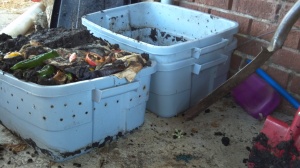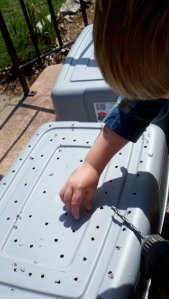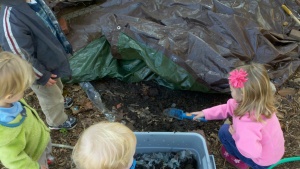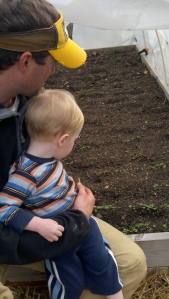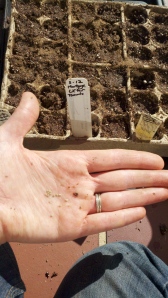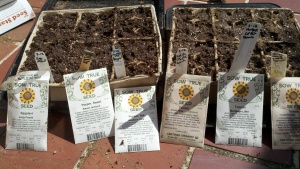Easter afternoon we were driving over to a cookout at James’s cousin’s house. Right around the corner from our house, I saw a person in a beekeeping suit in our neighbor’s yard. Well, I figured there must be a swarm so we pulled over to check it out.

The swarm
Sure enough, our neighbors had a swarm in their backyard. We told Andy, the beekeeper, that we had an empty bee box in our yard and were on a wait-list for getting bees this spring. He told us he’d captured 3 swarms in the past week, so he was all set on hives, and he offered to give us these bees. Woohoo!
He got them all corralled into his bee box, stapled some screen over the entrance, put them in the back of his pickup and followed us back around the corner to our house. He told us what we needed to do to get them transferred over to our bee boxes — I was listening intently, but not understanding much, with the notion in my brain that I’d call my brother ASAP to get him to come over and show me what to do with them later.

Andy getting the swarm into the box
Well, later came around, Craig got over here and we donned bee suits and transferred the racks from Andy’s box to ours. I was a little nervous as that was the first time I’d worked with bees since my one or two feeble teenaged attempts when my dad started tending a few hives in our backyard (I’m sure I was more scared of other teens seeing me in a bee suit than I was of the bees).

Craig and me, ready to go
Anyway, it was amazing. They were pretty calm but their collective buzz was steady and loud. I felt safe in the bee suit even though they were flying all around us. We got them all transferred, added a sugar water feeder to the front of the box to help feed them till they get established (in bee-speak, I think that means they’ve got to build their wax honeycomb cells up enough to be ready for them to put honey into…I think).

Bees in Andy's box on right, prior to transfer to our box on left
Of course, the boys were totally taken with the entire process — especially the bee suits. How cool to be able to look like a spaceman/alien and it doesn’t even have to be Halloween! They didn’t get too close to the hive but were watching what we were doing. They’re only 4 and 2. I wonder if it was instinct helping them keep a safe distance, or if they were following James’s lead (who didn’t have a suit but was also trying to watch from a couple yards away).

Amanda reloading the smoker
The next day, my brother and I had to go to Greenville for family business(not exciting stuff). We went to my Dad’s house while we were there to check on his four hives. When we got there, our friend Amanda was already there, suited up and checking the first hive.
Now, I am a complete beginner. So this might not all be exactly right. But, I learned that “checking on a hive” means that you’re making sure the hive is healthy: you go into the boxes, pull out the racks and see what’s going on. You look for brood cells, pollen cells, and of course cells filled with honey. (You also check for ick things like wax moths and some kind of parasitic beetle that can harm a hive.)

Opened bee box, checking racks

- Amanda at work
You also look for the queen — my favorite part of the entire activity. I’d always envisioned the queen as just kind of sitting still in one place, immobile, while the drones and worker bees helped move her around so she could lay eggs in the cells. Nope, the queen of the hive I first looked in was just as mobile and busy as all the other bees, moving around fairly nimbly for having a much longer abdomen than the others. We saw the queens in the other hives too and they have been working hard, making healthy bees and hives.
Learning by doing, baptism by fire — whatever this crash course in beekeeping was, it sure was fun. I did get stung once through my glove but it wasn’t too bad. I guess I was distracted by all the activity.

Here I am trying to figure out how to get the smoker to work, loading it up with sticks I’d carefully picked up from among a ridiculous amount of poison ivy in my dad’s yard. It is a true miracle I didn’t end up with a major PI problem. Thank goodness for the full coverage of the bee suit!
Amanda explained to me that the smoke confuses the bees by masking the pheromones they emit when they get mad (i.e., when people get in their hive), so they stay calmer.

Back in Asheville the past couple of days, I’ve been intrigued by these new residents in our backyard. I can see the hive from our porch. There’s a lot of activity right outside the entrance, but Craig assures me they’re not getting ready to swarm and leave. He says they’ve got to get their bearings, and he’s confident they like their new home.
This afternoon I told my 4 year old that we needed to go to the store. He asked, “Are we going there to get my bee suit?” I looked online and sure enough there’s a place that sells bee suits for kids. I think it’s great, but I know it will start World War III if my 2 year old doesn’t get one too (they don’t make them small enough for him)…he’ll just have to wait a little longer….and enjoy the honey in the meantime!

They're all in! (Sugar water feeder on the front helps them get established)
